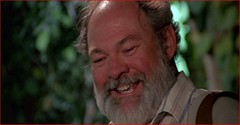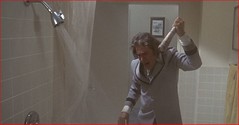
Wes Anderson's career technically started with the marvelous Bottle Rocket, but the career he is currently living out began with Rushmore. It was with Rushmore that Anderson introduced a comedic style that not only featured traditional jokes, but a variety of "static" jokes disguised as background objects, names and seemingly trivial details. The montage of Max Fischer's heavy involvement in scholastic clubs was a perfect introduction to this style, as it took up little screen time but obviously contained a wealth of comedy that would be revealed further on repeat viewings. This style of Anderson's would be applied in his two subsequent films, The Royal Tenenbaums and The Life Aquatic with Steve Zissou. Even though his upcoming The Darjeeling Ltd. looks to be less zany than those last two (obligatory: "why does it have to be zany?"), I'm infinitely thrilled to see it if only for seeing what details he serves up this time.
To me, this kind of comedy reminds me of the best moments of The Simpsons, where static jokes are treated like royalty by writers. But Anderson has quietly made this technique his own, and for me it doesn't get any better than in The Royal Tenenbaums. Here, I have listed (in all the not-so-obvious details, names and background objects I have noticed after many viewings. I intend to do this for the other two Anderson movies I mentioned as well.
- Pagoda serves Royal Tenenbaum a martini on a silver tray, after he informed his children of their parents' divorce.
- The cover of Etheline Tenenbaum's A Family of Geniuses seems to be a photograph taken at the book's very release junket, possibly indicating that we are seeing a later edition of the book.
- The Tenenbaum family flag, an elongated pink triangle with a simple "T" crest at its base, flies on a spire at the family's Archer Avenue house as well as their summer home on Eagle's Island. This same shade of pink is frequently worn by Royal and Pagoda during the movie.

- In a flashback to Royal addressing Margot as his adopted daughter, they are at a party and flanked by high-ranking military members apparently from Russia, Western Europe and the Middle East, as well as an old man in an outrageous houndstooth suit.
- At young Eli Cash's house, in the background there is a key holder bearing Sharpie inscriptions of "Eli's Keys" and "Aunt's Keys" with respective arrows. Young Eli is later seen wearing a key on a necklace.
- Royal wears the same outfit in all the childhood scenes: a tan coat with sunglasses and a lit cigarette.
- As he is getting dressed for a press event for his new book, Old Custer, Eli is assisted by three men -- one of which holds up a platter of finger sandwiches. Eli takes one bite.
- When we are introduced to Henry Sherman, he is apparently inside an apartment building he owns. Behind him are plaques with reminders of when garbage is picked up and other items. Below the text is "H. Sherman. Landlord."
- After Royal is informed that he must leave The Lindburgh Palace Hotel, we see his masseuse packing his bags while he looks out the window and smokes.

- The name of the reggae band Margot got involved with is Desmond Winston Manchester XI (the name of the album is illegible on my TV, anyone?)
- The names of Margot's plays we see on posters in her room include and Nakedness Tonight and Erotic Transference.
- Raleigh St. Claire's office is filled with various outdated technology, including a bizarre multiline rotary phone and random vacuum tube switchboards.
- The three former suitors of Etheline are: Neville Smythe (a British Arctic explorer), Yasuo Oshima (an Asian architect) and Franklin Benedict (a John Huston-like director with an eye patch, cigarette and a set filled with an Indiana Jones lookalike, a pair of amphibious people, a space man and an obscured production chair, of which we can see the word "Galaxion").
- While meeting with Pagoda, Royal calls Henry a "two-bit chartered accountant."
- The Tenenbaum's neighborhood varies radically with each side of the house: one side is in an upscale area next door to the Thai embassy, another is in a downtrodden area and a third side is on a wooded street with a bus stop.
- Margot's closet still contains her leopard costume used in the play performed on her birthday.

- Eli is seen smoking a peace pipe.
- Eli's apartment features the spectacular "Aggressively Mediocre/Mentally Challenged/Fantasy Island (circle one)" paintings by Miguel Calderon.
- Richie is seen reading Three Plays by Margot Tenenbaum. The book can't be any longer than 150 pages, and though the names of the plays listed on the cover are illegible, none of them look to be the previously mentioned titles.
- Henry Sherman's desk has an urn on it, presumably containing the remains of his wife who died of stomach cancer.
- In addition to the previously mentioned former suitors, Henry and Etheline recall Gen. Doug Cartwright in conversation.
- Rotary payphones are frequently featured in shots, often in strange locations such as near the water of a public swimming pool and on the roof of a rec center.
- A gravestone observed by Royal and Richie reads "drowned in the Caspian Sea."
- During the broadcast of Richie's infamous tennis meltdown, the play-by-play man is voiced by Wes Anderson. His color analyst is named Tex Hayworth.
- Eli's apartment has a large table saw and a mounted bull's head with a lasso around the horns.

- Richie is often seen drinking a Bloody Mary.
- The magazine sent from Eli to Etheline has a note that reads "Dear Mrs. Tenenbaum, just in case you missed it. --Eli."
- Eli's cover story is titled "Where the Wild Things Are" and has a deck that reads "New work reopens genre. Adam Scher talks with the James Joyce of the West."
- Eli's previous novel was titled Wildcat.
- Royal tells a cabbie to take him to the "375th St. Y" and their destination bears that literal title.
- The novel The Royal Tenenbaums that the movie supposedly follows is very poorly written. When chapter headings introduce scenes, they begin with lines like "Royal is wearing his wool hat" or "they pull up in front of a building that looks like a huge castle."
- When Chas is chasing Eli through the house during the wedding, Pagoda stops Eli with some sort of food and says "hey man, try this it's very tasty." Eli eats it.
- Margot's play we see near the end, Levinsons in the Trees, appears to be based on the miniature set we see her playing with in the beginning.












9 comments:
I'm not sure how Wes Anderson's exceptional attentiveness to detail fits in with his grand unified theory of whimsy, but I'm pretty confident that it does. Perhaps it has something to do with children see the world.
A complaint commonly lobbed at Wes Anderson is that all his stories are about how horrible it is to grow up. While this is sort of true, I think it would maybe be more accurate to say that a big part of the films is about how horrible it is to be grown up. It's not about childishness, it's about adultness, which is perhaps a source of the films' pervasive sense of melancholy.
-----
Eli: Well, everyone knows Custer died at Little Bighorn. What this book presupposes is ... maybe he didn't.
I like your adultness explanation, you could easily apply that to almost every character in his movie. It's also true that the kids in Anderson's movies don't really act their age.
Nice breakdown Adam,
Tenenbaums is in my top 10 of all time. One of my favorite scenes is from a series of the static shots you describe between Owen and Luke Wilson. Owen sits on the couch behind one of the paintings while Luke stands by the fireplace mantle with another painting behind him. Owen says "what?" and Luke then says "what?" back. The two go back and forth wondering if the other just said something. The scene is less about them and more about the outrageous paintings behind them. It's not a new joke, but it's shot in an interesting way and I love it.
I've been having Wes Anderson Month at Shoot the Projectionist all September; I loved this essay so I linked to it today.
Also, I'm conducting a survey to be published on Halloween, the 31 GREATEST HORROR FILMS. I'd love it if you--or anyone else interested in such matters--would contribute a nominating list and vote for the final list.
Here's a link to the original announcement:
http://shoottheprojectionist.
blogspot.com/2007/09/31-greatest-
horror-films-survey.html
love the list.
the plays on margot tenenbaum's book appear to be "erotic transference," "static electricity" and "nakedness tonight." i believe these plays show up before as posters in her room at home.
haha yeah this guys were very crazy in many ways in 80s I still guess that this was healthy in someways.
hmm nice creativity.. really awesome.. i like the whole content.. whatever that movie have its nicely shown in your pic.. I would like to invite you to take a look to generic viagra , you will find some good stuff there.
such a nice way you post the blog your blog is so creative please keep updating
Generic Viagra buy
Generic Viagra
Tadalis SX
Generic Viagra
Sildenafil citrate
Caverta
Kamagra
Online buy Generic Viagra
The name of the album is Dynamite Stick
:)
Post a Comment